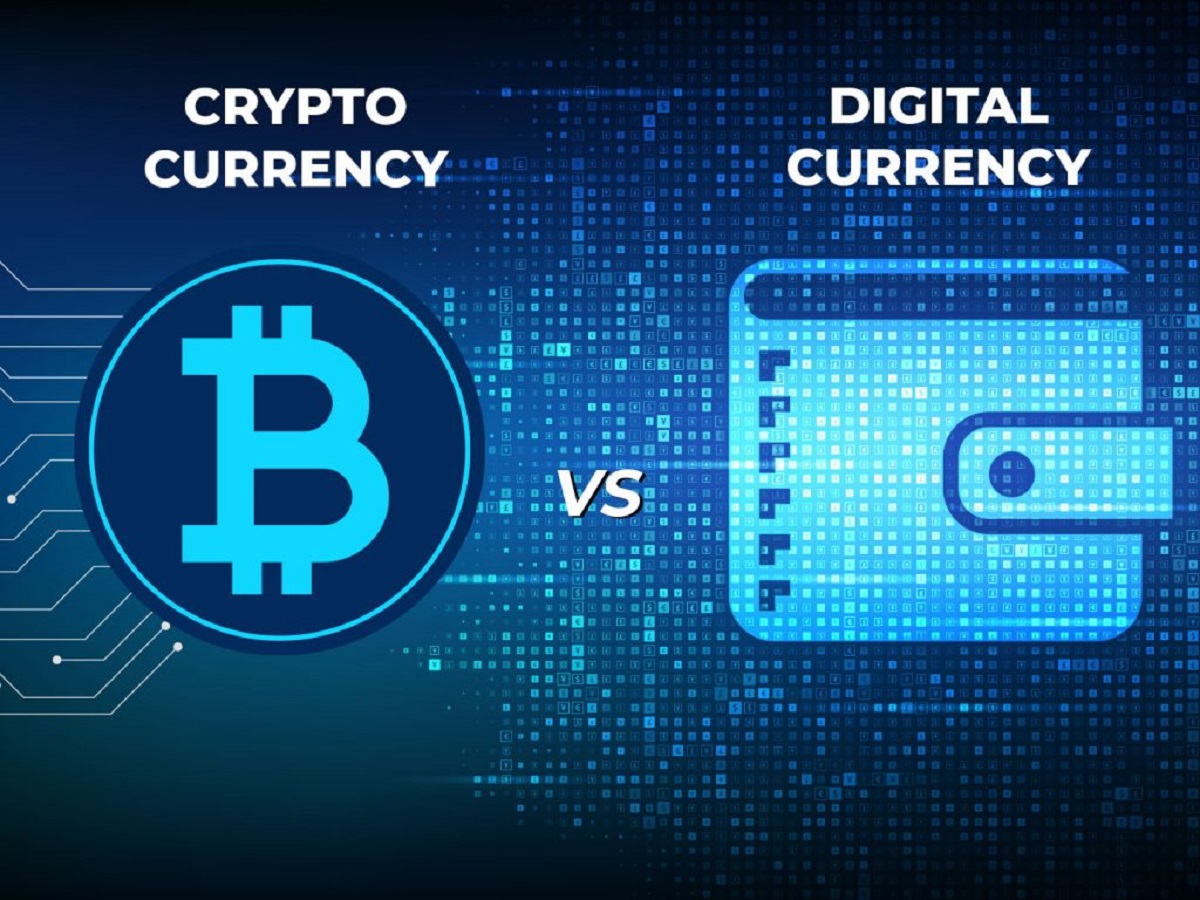Introduction
Welcome to the world of digital currencies! In recent years, there has been a surge in interest and adoption of various forms of digital currencies, most notably Central Bank Digital Currencies (CBDCs) and cryptocurrencies like Bitcoin. These digital assets have become a hot topic of discussion, both in the financial sector and among the general public. However, it is important to understand that CBDCs and cryptocurrencies are fundamentally different in several key aspects.
Central Bank Digital Currency, as the name suggests, is a digital form of a country’s fiat currency, issued and regulated by the central bank. On the other hand, cryptocurrencies like Bitcoin are decentralized digital currencies that operate on a peer-to-peer network without the oversight of a central authority. This fundamental difference in structure and governance sets the stage for contrasting characteristics in terms of ownership and control, system organization, monetary policy, transaction speed, privacy, security, regulations, and global acceptance.
In this article, we will delve into the intricacies of CBDCs and cryptocurrencies, examining the distinguishing features and highlighting how they shape the landscape of the digital economy. By understanding these differences, we can appreciate the unique potential and challenges associated with these digital currencies, shedding light on their respective roles in the broader financial ecosystem.
Definition of Central Bank Digital Currency (CBDC)
A Central Bank Digital Currency (CBDC) is a digital form of a country’s fiat currency that is issued and regulated by the central bank. Unlike physical banknotes and coins, CBDC exists solely in the digital realm and can be used for electronic payments and transactions. It is designed to be a secure and convenient means of conducting financial transactions, offering benefits such as increased efficiency, financial inclusion, and enhanced transparency.
CBDCs can be classified into two main types: retail CBDC and wholesale CBDC. Retail CBDC is primarily intended for general public use and is accessible to individuals and businesses for making everyday transactions, just like traditional currency. On the other hand, wholesale CBDC is limited to financial institutions and is primarily used for interbank settlements and other large-scale financial transactions.
One of the key features of CBDCs is that they are issued and controlled by the central bank, giving them a high level of authority and oversight. This centralized nature allows the central bank to maintain control over the monetary policy and influence the country’s financial ecosystem. Additionally, CBDCs are typically backed by the full faith and credit of the government, ensuring their stability and acceptance as a legitimate form of currency.
CBDCs can be implemented using different technological frameworks, such as blockchain or distributed ledger technology (DLT). These technologies can enhance the security, traceability, and efficiency of transactions, providing a robust infrastructure for the digital currency.
While CBDCs offer several potential advantages, such as faster and cheaper transactions, financial inclusion, and reduced reliance on cash, there are also various considerations and challenges to address. These include the potential impact on commercial banks, privacy concerns, cybersecurity risks, and the need to establish regulatory frameworks to prevent illicit activities.
Overall, CBDCs represent an evolution of traditional fiat currencies into the digital age, providing central banks with new tools to shape the financial landscape and address emerging challenges. As countries around the world explore the potential implementation of CBDCs, thorough research, careful planning, and collaboration with various stakeholders are crucial to ensure successful and responsible adoption.
Definition of Cryptocurrency
Cryptocurrency is a digital or virtual form of currency that utilizes cryptographic technology to secure and verify transactions. Unlike traditional fiat currencies, cryptocurrencies operate on decentralized networks known as blockchain, which records and validates each transaction made with the currency.
One of the defining characteristics of cryptocurrencies is its decentralized nature. This means that cryptocurrencies are not controlled or regulated by any central authority, such as a government or a central bank. Instead, they are governed by a consensus mechanism, often referred to as proof-of-work or proof-of-stake, where participants in the network validate and verify transactions.
Cryptocurrencies are created through a process called mining or minting, where powerful computers solve complex mathematical puzzles to validate transactions and add them to the blockchain. This process also introduces new units of the cryptocurrency into circulation, which is controlled by predetermined rules and algorithms set by the cryptocurrency’s creator.
Each cryptocurrency is unique and operates on its own rules and principles. Bitcoin, the first and most well-known cryptocurrency, was created in 2009 by an anonymous person or group known as Satoshi Nakamoto. Since then, thousands of different cryptocurrencies, often referred to as altcoins, have been introduced, each with its own features and functionalities.
Cryptocurrencies are typically exchanged and traded on specialized online platforms known as cryptocurrency exchanges. These exchanges allow users to buy, sell, and trade cryptocurrencies using various fiat currencies or other cryptocurrencies.
One of the key features of cryptocurrencies is the transparency and security they offer. Transactions made with cryptocurrencies are recorded on the blockchain, a public and immutable ledger, which allows for greater transparency and traceability of transactions. Additionally, the cryptographic technology used in cryptocurrencies provides a high level of security, making it difficult for transactions to be altered or counterfeited.
While cryptocurrencies offer several advantages, such as financial inclusivity, borderless transactions, and potentially high investment returns, they also come with risks and challenges. These include price volatility, regulatory uncertainties, cybersecurity threats, and the potential for misuse in illegal activities.
In summary, cryptocurrencies are digital or virtual currencies that operate on a decentralized network, using cryptographic technology to secure transactions. As the popularity of cryptocurrencies continues to grow, further innovation and development of this digital asset class are expected, potentially shaping the future of finance and transactions.
Ownership and Control
One of the fundamental differences between Central Bank Digital Currencies (CBDCs) and cryptocurrencies lies in the aspect of ownership and control. CBDCs are issued and regulated by the central bank of a particular country, which means that the central bank has full control over the issuance, supply, and distribution of the digital currency. This centralization allows for greater regulatory oversight and the ability to implement monetary policies to stabilize the economy.
In contrast, cryptocurrencies, such as Bitcoin, are decentralized by design. They operate on a peer-to-peer network, with no central authority or entity responsible for their creation or regulation. Instead, ownership and control of cryptocurrencies are distributed among the participants of the network, who collectively validate transactions and maintain the integrity of the blockchain.
This decentralized nature of cryptocurrencies provides a number of advantages, such as resistance to censorship, reduced reliance on intermediaries, and the potential for greater financial autonomy. However, it also means that there is no single entity or institution accountable for the stability, security, or governance of the cryptocurrency. As a result, the responsibility for the ownership and control of cryptocurrencies lies solely with the individual users.
When it comes to CBDCs, ownership is typically tied to individuals’ bank accounts within the central bank’s digital infrastructure. Users have access to their CBDC holdings through authorized financial institutions or digital wallets, which can be linked to their personal identification and banking information. This process ensures a certain level of user protection, as CBDCs operate within the existing banking and regulatory framework.
However, the ownership and control of CBDCs can also raise concerns regarding financial privacy and surveillance. As CBDC transactions are recorded and monitored by the central bank, there may be potential implications for individuals’ financial privacy, depending on the level of transparency and access to transaction data. Striking the right balance between privacy and regulatory oversight is crucial in the implementation of CBDCs.
Overall, while CBDCs offer centralized ownership and control, cryptocurrencies offer a decentralized ownership structure. Both approaches have their advantages and drawbacks, and the choice between them depends on the specific goals, values, and requirements of each economy and its users.
Centralized vs. Decentralized System
Centralized and decentralized systems are at the core of the distinction between Central Bank Digital Currencies (CBDCs) and cryptocurrencies. The centralized system is characteristic of CBDCs, where a central authority, typically the central bank, has control over the issuance, regulation, and governance of the digital currency.
In a centralized system, the central bank acts as the trusted intermediary, facilitating transactions, monitoring the flow of funds, and ensuring compliance with regulations. This centralized approach provides a certain level of stability and accountability, as the central bank can adjust the monetary policy and respond to economic fluctuations. It also allows for faster and more efficient oversight, making it easier to combat fraudulent activities and money laundering.
On the other hand, cryptocurrencies operate on a decentralized system. As mentioned earlier, cryptocurrencies utilize blockchain technology, which is a distributed ledger maintained and updated by a network of nodes. Each node in the network contains a copy of the blockchain, ensuring transparency and security. Transactions on the blockchain are validated through a consensus mechanism, without the need for a centralized authority to oversee and authorize them.
Decentralization offers several advantages, such as increased resilience to hacking or system failures, as the network does not rely on a single point of failure. It also provides greater user empowerment, as individuals have direct control over their cryptocurrency holdings and can transact with others without the need for intermediaries.
However, decentralized systems also come with challenges. The absence of a central authority can result in slower decision-making processes and difficulties in implementing changes or upgrades to the network. As the responsibility for transaction validation is distributed among network participants, there may also be concerns regarding the efficiency and scalability of the system, particularly during periods of high transaction volume.
Both centralized and decentralized systems have their place in the digital currency landscape. While CBDCs, with their centralized control, offer familiarity, stability, and regulatory oversight, cryptocurrencies provide a decentralized alternative that promotes individual autonomy, transparency, and resilience. The choice between the two depends on the objectives, values, and priorities of the economy and the users within it.
Monetary Policy and Stability
Monetary policy is a crucial aspect of any financial system, and it significantly differs in the context of Central Bank Digital Currencies (CBDCs) and cryptocurrencies. CBDCs are governed by the central bank and operate within an established monetary policy framework. This allows the central bank to exercise control over the supply and circulation of the currency, adjusting interest rates and implementing measures to maintain economic stability.
With CBDCs, the central bank can directly influence factors such as inflation, economic growth, and employment by controlling the supply of digital currency. By adjusting interest rates on digital transactions and implementing targeted monetary policies, the central bank can stimulate or subdue economic activity as needed. This centralized management enables governments to respond more effectively to economic challenges and implement policies to mitigate financial crises.
On the other hand, cryptocurrencies like Bitcoin operate on decentralized networks, which lack a single governing authority. As a result, the traditional tools of monetary policy, such as interest rate adjustments, do not directly apply. Cryptocurrencies have their own mechanisms to control the supply and circulation of the currency, often through predetermined algorithms and rules defined at the initial stages.
The monetary stability of cryptocurrencies depends on factors such as market forces, adoption, and demand. As the value of cryptocurrencies is determined by supply and demand dynamics, fluctuations in price and volatility are common. Some cryptocurrencies, like stablecoins, attempt to minimize this volatility by pegging their value to an underlying asset or a fiat currency.
While the decentralized nature of cryptocurrencies allows for greater autonomy and avoids centralized monetary manipulation, it can also introduce challenges for stability. Without a governing authority, cryptocurrencies can be susceptible to price manipulation, market speculation, and external market forces that may trigger significant price fluctuations.
In summary, CBDCs give central banks a greater degree of control over monetary policy, offering stability and the ability to respond to economic conditions. Cryptocurrencies, on the other hand, operate on decentralized networks and are subject to market forces. While this decentralized approach provides a level of democratic autonomy, it may result in price volatility and potential challenges in achieving monetary stability. Understanding these distinctions is crucial in assessing the implications and potential impact of CBDCs and cryptocurrencies on monetary policy and financial stability.
Transaction Speed and Scalability
Transaction speed and scalability are important considerations when comparing Central Bank Digital Currencies (CBDCs) and cryptocurrencies. These factors play a critical role in determining the efficiency and practicality of digital currencies for everyday transactions and broader adoption.
CBDCs, being centralized systems, have the potential to offer high transaction speeds and scalability. As the central bank oversees the entire digital currency infrastructure, it can implement technologies and protocols to enable fast and seamless transactions. This involves optimizing the digital payment systems, ensuring secure and reliable networks, and implementing efficient clearing and settlement mechanisms.
Furthermore, CBDCs can leverage existing payment infrastructure, such as interbank systems and digital wallets, to facilitate instant transactions. This integration with established financial systems enables CBDCs to achieve faster transaction settlement times, comparable to traditional digital payment methods like credit cards or electronic fund transfers.
However, the scalability of CBDCs can be a challenge. As the usage and adoption of a CBDC increase, the infrastructure must be able to handle a larger volume of transactions. This requires robust technology and processing capabilities to ensure that the system can scale without compromising speed and performance.
In contrast, transaction speeds and scalability in the world of cryptocurrencies vary significantly. Traditional cryptocurrencies like Bitcoin, operating on a proof-of-work consensus mechanism, face scalability challenges due to limited transaction processing capacity. The decentralized nature of cryptocurrencies means that all transaction validations are performed by network participants, which can result in slower transaction speeds when the network is congested.
However, advancements in blockchain technology and the emergence of alternative consensus mechanisms, such as proof-of-stake, have paved the way for cryptocurrencies to improve transaction speed and scalability. Newer cryptocurrencies, such as Ripple and Ethereum, have implemented protocols that allow for faster and more scalable transactions, enabling higher throughput and reducing confirmation times.
It is important to note that while cryptocurrencies may offer faster transaction speeds than traditional financial systems, they may still fall short of the instantaneous transaction settlement that CBDCs can potentially achieve.
In summary, CBDCs, with their centralized systems and integration with existing financial infrastructure, have the potential to achieve high transaction speeds and scalability. Cryptocurrencies, on the other hand, offer varying transaction speeds and scalability depending on the specific blockchain technology and consensus mechanism used. As both CBDCs and cryptocurrencies continue to evolve, technological advancements and further innovation will play a vital role in enhancing transaction speed and scalability for digital currencies.
Privacy and Anonymity
Privacy and anonymity are critical factors to consider when comparing Central Bank Digital Currencies (CBDCs) and cryptocurrencies. Both forms of digital currency have implications for individuals’ financial privacy and the level of anonymity they offer in transactions.
CBDCs, being issued and regulated by the central bank, often prioritize transaction transparency and regulatory compliance. This means that while individuals may have some degree of privacy, the central bank typically has access to transaction data, including the identities of the parties involved in the transactions. The level of privacy can vary depending on the design and implementation of the CBDC, with some countries adopting stringent know-your-customer (KYC) and anti-money laundering (AML) measures to ensure regulatory compliance.
On the other hand, cryptocurrencies offer varying degrees of privacy and anonymity. Some cryptocurrencies, like Bitcoin, operate on public blockchains, which means that all transactions are visible to anyone with access to the blockchain. While the transactions are pseudonymous, meaning that they are tied to a cryptographic address rather than personal identification, the transparency of the blockchain allows for the traceability of transactions.
However, privacy-enhancing technologies and platforms, such as privacy coins and mixers, offer increased anonymity for cryptocurrency transactions. Privacy coins utilize cryptographic techniques to obfuscate transaction details, making it more challenging to trace the flow of funds. Mixers, on the other hand, enable users to combine their transactions with other users, making it harder to link specific transactions to individuals.
It is important to note that the level of privacy and anonymity in cryptocurrencies can vary depending on the specific cryptocurrency and the measures implemented by users to enhance privacy. Additionally, regulatory requirements and compliance may affect the level of anonymity that can be achieved when converting cryptocurrencies into traditional fiat currencies.
With both CBDCs and cryptocurrencies, there is a balance to be struck between privacy and regulatory requirements. Striking this balance ensures that individuals’ financial privacy is respected while mitigating the risks of illicit activities, such as money laundering and terrorism financing.
Ultimately, the approach to privacy and anonymity varies between CBDCs and cryptocurrencies. CBDCs prioritize transaction transparency and regulatory compliance, intending to strike a balance between privacy and the need for accountability. Cryptocurrencies, on the other hand, offer varying levels of privacy and anonymity, with privacy-focused cryptocurrencies providing a higher degree of transaction obfuscation. As the digital currency landscape continues to evolve, it is essential to address privacy concerns to foster trust and adoption among users.
Security and Regulations
Security and regulations are crucial aspects when considering the differences between Central Bank Digital Currencies (CBDCs) and cryptocurrencies. Both forms of digital currencies face unique challenges and considerations in terms of security measures and regulatory frameworks.
CBDCs benefit from the stable and established institutional framework of central banks, which have extensive experience in managing and safeguarding financial systems. The central bank is responsible for implementing robust security measures to protect the digital currency infrastructure from cyber threats and ensure the integrity of transactions. This includes encryption protocols, secure storage methods, and risk management frameworks to mitigate potential risks.
In terms of regulations, CBDCs operate within existing legal and regulatory frameworks that govern the financial sector. This ensures compliance with anti-money laundering (AML) and know-your-customer (KYC) regulations, as well as other consumer protection measures. The centralized nature of CBDCs allows for regulatory oversight and the ability to enforce compliance measures to prevent illicit activities.
On the other hand, cryptocurrencies face unique security challenges due to their decentralized nature. While cryptographic protocols provide a high level of security for transactions, the distributed nature of blockchain networks can make them vulnerable to hacking attempts and other cyber threats. Cryptocurrency exchanges, where cryptocurrencies are bought and sold, have also been the target of cyberattacks leading to the loss of funds.
Regulatory frameworks surrounding cryptocurrencies vary significantly across jurisdictions. Some countries have introduced regulations to address issues such as money laundering, tax evasion, and investor protection. However, the decentralized nature of cryptocurrencies presents challenges in implementing global, uniform regulations. Striking a balance between regulation and innovation is essential to ensure consumer protection, financial stability, and the prevention of illegal activities.
Efforts are being made to further enhance the security and regulations surrounding both CBDCs and cryptocurrencies. For CBDCs, central banks collaborate with cybersecurity experts and adopt best practices to strengthen the resilience of the infrastructure. For cryptocurrencies, regulatory frameworks are being developed to address security concerns, protect investors, and prevent illegal activities.
It is important to note that security and regulations evolve alongside the development and adoption of digital currencies. The collaboration between technologists, financial institutions, regulators, and policymakers is crucial to strike a balance that ensures the security of the digital currency ecosystem while fostering innovation and maintaining user trust.
Ultimately, both CBDCs and cryptocurrencies require robust security measures and appropriate regulatory frameworks to ensure the stability and integrity of the digital currency system.
Adoption and Global Acceptance
Adoption and global acceptance are key factors that determine the success and impact of Central Bank Digital Currencies (CBDCs) and cryptocurrencies. While both have the potential to revolutionize the financial landscape, they face unique challenges and opportunities in terms of widespread adoption and acceptance.
CBDCs have the advantage of being issued and regulated by central banks, which are trusted institutions with a significant influence on the economy. This provides CBDCs with a level of credibility and familiarity that can lead to faster adoption. Central banks can leverage their existing infrastructure and relationships with financial institutions to facilitate the integration and acceptance of the digital currency. Additionally, governments have the power to enforce the use of a CBDC and incentivize its adoption through policies and regulations.
However, the successful adoption of CBDCs depends on multiple factors, including user trust, technical infrastructure, and public acceptance. Educating users about the benefits and functionalities of CBDCs, addressing concerns related to privacy and security, and ensuring accessibility to all segments of the population are crucial in driving widespread adoption.
On the other hand, cryptocurrencies face diverse challenges in achieving global acceptance. While they have gained significant popularity and recognition, cryptocurrencies still face skepticism and regulatory uncertainties in many jurisdictions. Lack of standardized regulations, concerns about security and stability, and volatility in cryptocurrency prices are some of the factors that impact global acceptance.
However, cryptocurrencies offer unique advantages that contribute to their global adoption. These advantages include borderless transactions, financial inclusivity, lower transaction fees, and potential for investment growth. As cryptocurrencies continue to innovate and address regulatory concerns, they have the potential to become more widely accepted as a means of payment and store of value.
Moreover, the growing interest and investments in the cryptocurrency space by institutional investors, financial institutions, and tech companies are further driving the global acceptance of cryptocurrencies. In some countries, governments are actively exploring and implementing regulations to facilitate the use of cryptocurrencies in a regulated environment.
Recognizing the potential benefits and addressing the challenges associated with both CBDCs and cryptocurrencies are crucial in driving their adoption and global acceptance. Collaboration among governments, central banks, financial institutions, technology innovators, and regulators is essential to establish clear and comprehensive frameworks that foster trust, innovation, and stability in the digital currency ecosystem.
As the digital currency landscape continues to evolve, the path to widespread adoption and global acceptance will require ongoing collaboration, education, and innovation to ensure that CBDCs, cryptocurrencies, and other forms of digital currencies can effectively integrate into the global financial system.
Conclusion
In conclusion, Central Bank Digital Currencies (CBDCs) and cryptocurrencies offer unique features and possibilities in the digital currency landscape. While CBDCs are centralized digital currencies issued and regulated by central banks, cryptocurrencies operate on decentralized networks without the oversight of a central authority.
CBDCs provide stability, regulatory oversight, and scalability through their integration with existing financial systems. They have the potential to enable faster transactions, enhance financial inclusion, and offer governments greater control over monetary policy. However, CBDCs may raise concerns about privacy, surveillance, and dependence on central authorities.
On the other hand, cryptocurrencies offer advantages such as decentralization, peer-to-peer transactions, and potential for investment growth. They provide individuals with more financial autonomy and can serve as a hedge against inflation. However, cryptocurrencies face challenges related to scalability, regulatory frameworks, and security.
Understanding the differences between CBDCs and cryptocurrencies is essential in evaluating their implications and potential impact on the financial ecosystem. Both digital currencies present opportunities for innovation, financial inclusion, and efficient transactions. However, they also come with challenges that need to be addressed, such as privacy concerns, scalability, and regulatory frameworks.
As the digital currency landscape continues to evolve, it is crucial for governments, central banks, financial institutions, and regulators to collaborate and strike a balance between innovation and stability. Robust security measures, transparent regulations, and effective communication are vital in fostering user trust, widespread adoption, and global acceptance of digital currencies.
Ultimately, the successful integration and implementation of CBDCs, cryptocurrencies, and other digital currencies rely on continuous innovation, collaboration, and the ability to address the evolving needs and concerns of individuals, businesses, and economies around the world.

























